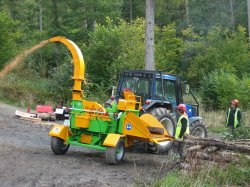 We are often asked whether it is possible to heat a property using an area of woodland on site. This method will provide you with a very rough figure of the quantities that could be supplied from a woodland. Figures obtained this way are useful in that they help to determine whether there is any point in doing further more detailed calculation by giving a broad indication.
We are often asked whether it is possible to heat a property using an area of woodland on site. This method will provide you with a very rough figure of the quantities that could be supplied from a woodland. Figures obtained this way are useful in that they help to determine whether there is any point in doing further more detailed calculation by giving a broad indication.
Please note: There are many of detailed estimates that you can do to measure standing timber volume and growth rates in woodlands to calculate yield. It is not a substitute for a Management Plan. You should not consider this method a substitute for detailed site and species specific measurement and advice. This method is merely to tell very roughly how much fuel it is plausible to get from a given area of woodland for rough initial calculations. Available material is subject to a successful felling licence application.
There is a more detailed method for assessing the quantity of timber available for fuel (which is based on a study in the Woolhope Dome in Herefordshire) and a section on managing yield here
You will need:
Depending on site conditions, foresters often assume that coniferous trees are capable of achieving a minimum of 8 cubic metres per hectare per year (m3/ha/yr) on most sites, and broadleaved species are capable of producing around 4. Bear in mind that this will vary considerably depending on site conditions, management history, the pressure on trees from pests, diseases and pollution etc. You also need to remember to take into account any open spaces within the woodland.
It is important to have a good idea of the sustainable output of a woodland, but bear in mind that, if you haven’t felled any timber for some time, there will be a larger stock of timber available in the woodland for the initial cut.
There is an Excel spreadsheet with densities of different species available here but a cubic metre of most species (when freshly cut) weighs around a tonne.
To convert from green (fresh) weight to dried weight:

Where:
Ww = Green weight
Wd = Dried weight
MCw = Green Moisture Content (wet basis, expressed as a decimal, e.g., 50% = 0.5)
MCd = Dried (target) Moisture Content (wet basis, expressed as a decimal, e.g., 10% = 0.1)
For more information on wet and dry basis measurements see Wood as Fuel – Technical Supplement. There are figures on green moisture contents of different species here but an average conifer MC is around 55% and a mean hardwood MC is around 50%.
Once you know the number of tonnes available and their moisture content, you can then estimate the number of kWh available from this amount of fuel by using this spreadsheet there are also some helpful figures here which should give you an idea of your annual heating and system size requirements.